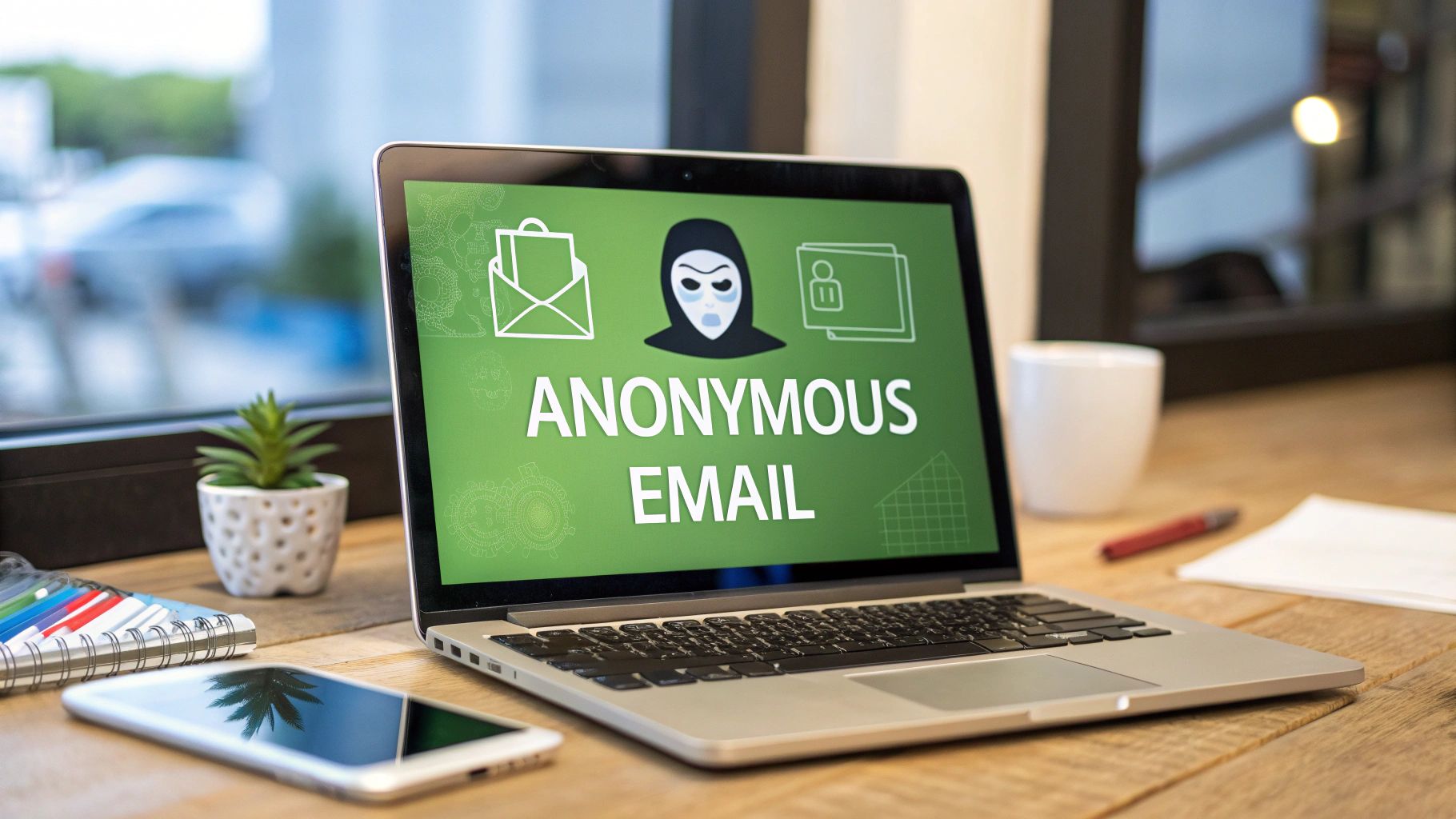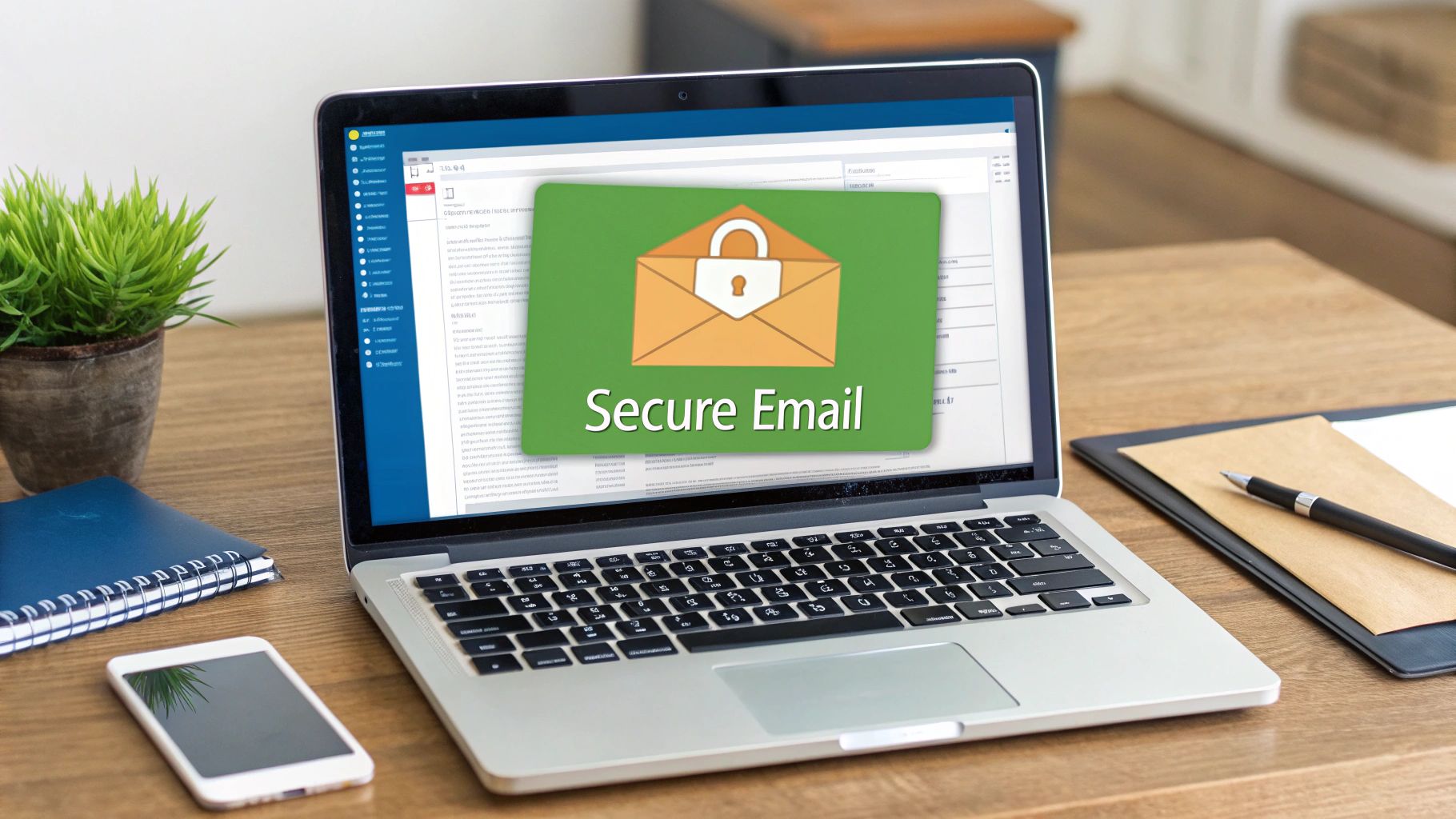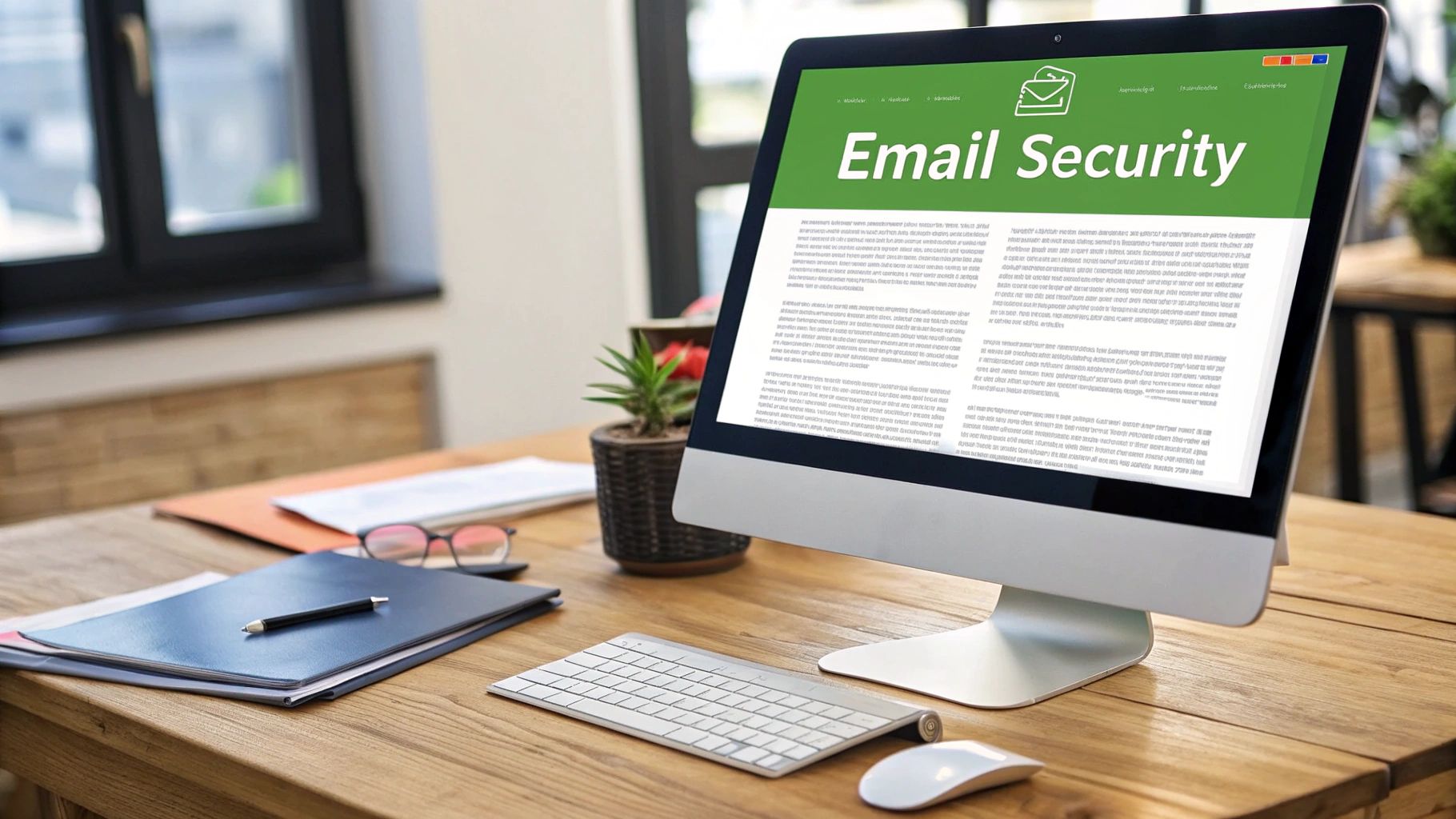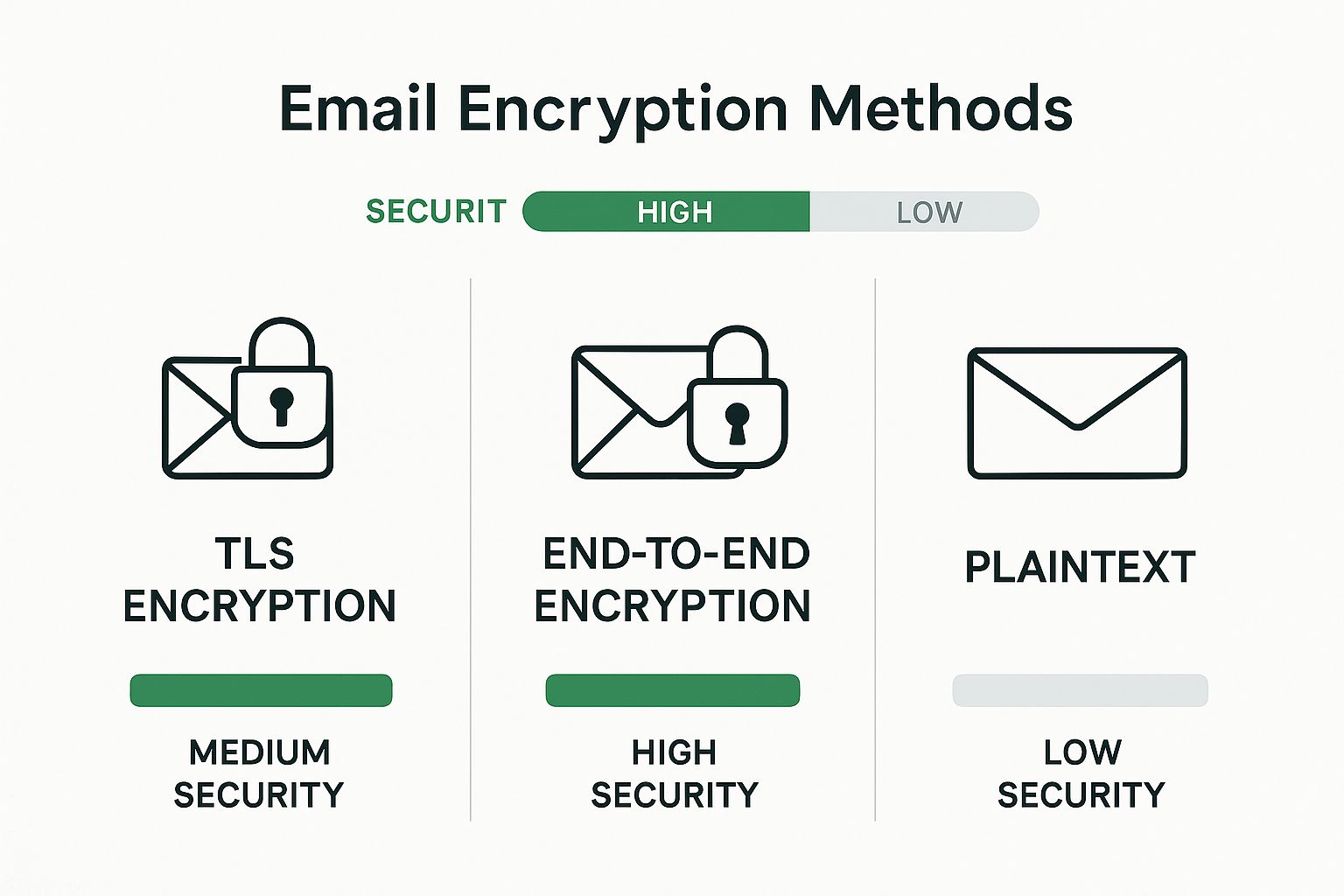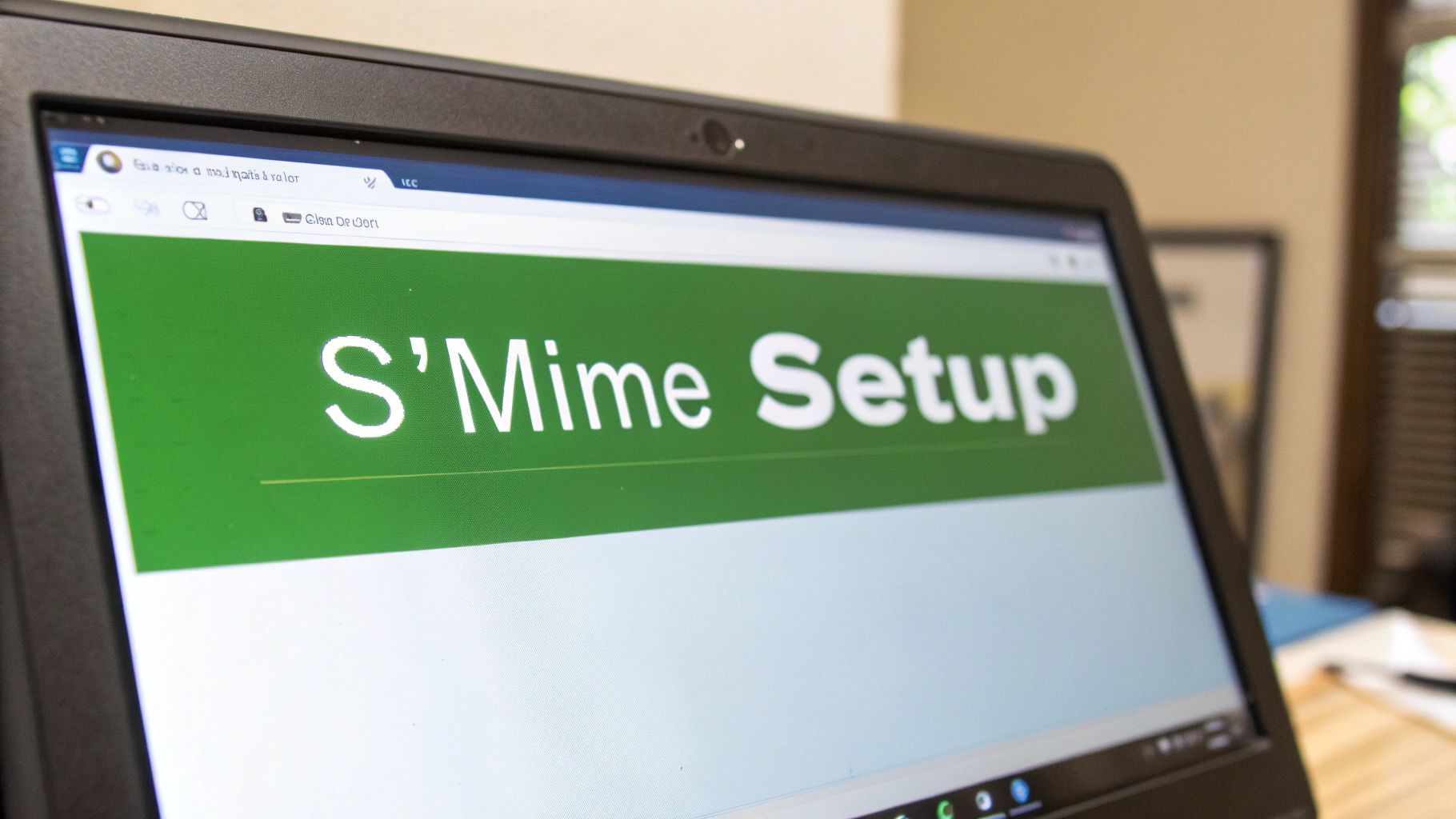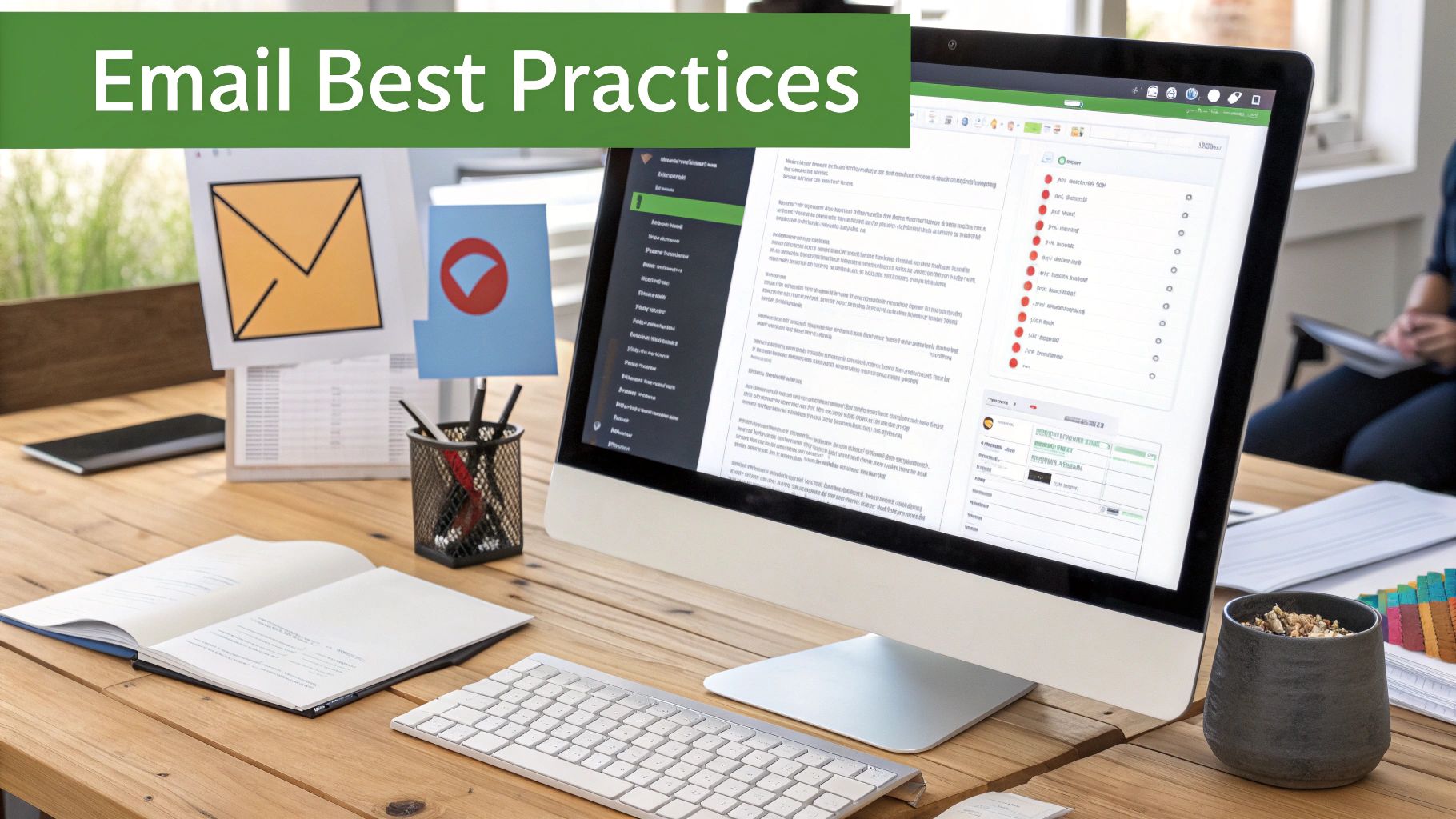Setting up an anonymous email isn't as complicated as it sounds. At its core, it's about picking a secure provider that doesn't keep logs, hiding your IP address with a tool like a VPN, and being mindful of your daily habits to keep your identity safe. This combination is what keeps your communications private and untraceable right from the get-go.
Why Bother With an Anonymous Email?
Let's get one thing straight: anonymous email isn't just for spies and whistleblowers. In an age of endless data breaches and trackers watching our every click, a private email is just smart digital self-defense. It’s all about taking back control over who gets to see your personal information.
Think about it in the real world. A journalist needs it to protect a source when handling a sensitive story. An activist uses it to organize without worrying about who's watching. For the rest of us, it’s a simple way to sign up for a newsletter, enter a contest, or join a forum without connecting that activity to our real name and life.
Keeping Your Digital Footprint Private
Every time you fire off an email from a standard account, you’re leaving behind a breadcrumb trail. Your name, location, and other personal details are often baked right in, creating a rich profile that advertisers and data brokers love to get their hands on. An anonymous email severs that link completely.
It's no surprise that millions are now creating anonymous emails to protect their privacy. This isn't a niche trend anymore. Just look at a service like ProtonMail, which now has over 70 million users. It shows a massive shift in how people view their online lives, with research suggesting that about 35% of internet users are now actively using tools like anonymous email to guard their identity. You can dig deeper into the numbers in this email statistics report.
The Three Keys to Real Anonymity
Getting to true anonymity isn't about flipping a single switch. It's more of a layered approach that rests on three essential pillars. If you get these right, you'll have a truly private way to communicate.
-
A Secure Provider: First, you need an email service that has a rock-solid, no-logs policy and uses end-to-end encryption. This is non-negotiable. It means even the provider can't read your emails or hand over your data.
-
A Hidden IP Address: Your IP address is basically your home address online. By using a Virtual Private Network (VPN) or the Tor Browser, you can hide your real IP, making it nearly impossible to trace your activity back to you.
-
Smart Daily Habits: The best tech in the world won't help if you're careless. True anonymity requires conscious effort. This means not using personal details in your emails and, of course, using strong, unique passwords for everything.
The whole point is to build a secure bubble around your communications. By combining the right provider, IP masking, and some common-sense habits, you create a clean break between what you do online and who you are in the real world. We'll walk through exactly how to do it.
Building Your Digital Anonymity Toolkit
Before we even get to picking an email provider, we need to lay the groundwork. Think of it as building a secure foundation. If you skip this part, even the most private email service won't do you much good because your own internet connection can give you away.
The biggest culprit is your IP address—it’s like a digital fingerprint for your internet connection. Hiding it is non-negotiable for true anonymity. Your two main tools for the job are a Virtual Private Network (VPN) or the Tor Browser. They work differently, so let's break down which one is right for you.
Securing Your Connection: VPN vs. Tor
A VPN creates an encrypted tunnel for your internet traffic, sending it through a server somewhere else in the world. This simple move swaps your real IP address with the VPN server's IP. It’s a great all-around tool for day-to-day anonymous browsing and is usually much faster than Tor.
If you go the VPN route, there are a couple of must-have features:
- A Strict No-Logs Policy: This is critical. It means the provider doesn't keep any records of what you do online. If they don't have the data, no one can force them to hand it over.
- An Automatic Kill Switch: If your VPN connection ever drops, this feature immediately cuts off your internet access. It’s a safety net that prevents your real IP from being accidentally exposed.
The Tor Browser takes a more complex approach. It bounces your traffic through a series of volunteer-run servers, called "nodes," all over the globe. Each hop adds another layer of encryption, making it incredibly difficult for anyone to trace your activity back to you. This offers a much higher degree of anonymity but comes at a cost: your internet speed will take a noticeable hit.
This table gives you a quick side-by-side look to help you decide.
Comparing Core Anonymity Tools: VPN vs. Tor
| Feature | VPN (Virtual Private Network) | Tor Browser |
|---|---|---|
| Primary Use | General privacy, geo-unblocking, and securing public Wi-Fi. | Maximum anonymity for sensitive activities. |
| Anonymity Level | Good. Hides your IP from websites, but you must trust the VPN provider. | Excellent. Multi-layer encryption makes tracing extremely difficult. |
| Speed | Generally fast, with minimal impact on connection speed. | Significantly slower due to the multi-hop routing process. |
| Ease of Use | Very simple. Usually involves installing an app and clicking "connect." | Easy to use for browsing, but requires more technical understanding for advanced setups. |
| Trust Model | You trust the VPN provider not to log or share your data. | Distributed trust across thousands of volunteer nodes; no single entity to trust. |
Ultimately, a VPN is perfect for most people who just need solid, everyday privacy. Tor is the tool for when you need the highest level of protection and are willing to sacrifice speed for it.
The image below lays out the key components you'll need to assemble your complete anonymity toolkit.

As you can see, securing your connection and browser is just as important as the email provider you eventually choose.
Beyond Your Connection: Browser and Search Engine Privacy
Your everyday web browser is another privacy leak. Browsers like Chrome can build a unique "digital fingerprint" from your settings, extensions, and hardware. This can make you trackable even if you block cookies. Ditch it for a privacy-first browser like Brave, which blocks trackers right out of the box.
Don't stop there—your search engine matters, too. If you're using a private browser but searching on Google, you're still leaving a trail. Pair your browser with a search engine like DuckDuckGo, which doesn't log your search history or tie it to you.
A strong anonymous setup is all about layering your defenses. It’s not just about the email provider. You also have to manage your email metadata—things like the sender's IP and device info—to cut off any trails leading back to you. When you combine these habits with a VPN, which an estimated 200 million people use every month, you build a powerful shield for your identity. You can dig into more user trends by checking out this email usage research.
Nailing this toolkit from the get-go helps you avoid simple mistakes that could unravel all your hard work later. Once your connection and browser are locked down, you're finally ready to pick the right email provider.
How to Choose the Right Anonymous Email Provider

Now that you have your basic privacy toolkit ready, we've arrived at the most critical step: choosing your email provider. This decision is about more than just a slick interface or a ton of storage. It's about who you trust with your data.
You need to look for a service that was built from the ground up with privacy as its foundation, not as an afterthought. This philosophy really gained traction after the surveillance revelations of the 2010s. The launch of ProtonMail in 2014, for example, was a game-changer. It was built by CERN scientists on the principle of end-to-end encryption and didn’t demand personal info to sign up.
That history gives us a solid blueprint for what to look for today.
Encryption: The Bedrock of Your Privacy
First things first, you have to scrutinize a provider's encryption model. You’ll run into two terms constantly: end-to-end encryption and zero-access encryption. They sound similar, but the difference is huge.
-
End-to-End Encryption (E2EE): This is the gold standard for communication. It means your email is scrambled into unreadable code on your device and can only be unscrambled by the intended recipient. No one in the middle—not even the provider—can read it.
-
Zero-Access Encryption: This is about data at rest. It guarantees the company has literally zero ability to access anything you store on their servers (emails, contacts, files). Why? Because you hold the key, not them.
For true anonymity, you need both. Services like ProtonMail and Tutanota are excellent examples of providers who get this right, making sure your messages are locked down both in transit and on their servers.
Where Your Provider Lives Matters
This might sound overly cautious, but a company's physical headquarters dictates which government's laws it has to follow. This is a massive deal when it comes to data requests from law enforcement.
My Advice: Stick with providers based in countries with ironclad privacy laws, like Switzerland or Germany. Their legal systems make it incredibly difficult for authorities to demand user data, unlike countries within the Five Eyes intelligence alliance (like the U.S., U.K., and Canada).
This single choice could be the difference between your data staying private and ending up in a government surveillance dragnet.
The Sign-Up Process and No-Logs Policy
A provider’s commitment to your anonymity is immediately obvious during the sign-up process. The best services ask for as little information as possible.
Here’s a quick mental checklist I run through:
- No Phone Number? If a service demands a phone number for verification, I'm out. That instantly ties your "anonymous" account to your real-world identity. It’s a deal-breaker.
- No Personal Recovery Email? Linking your primary Gmail account as a recovery option completely undermines the whole point. Look for providers that offer offline recovery methods, like a secure phrase you write down.
- Anonymous Payments? If you decide to upgrade to a paid plan, can you do it without leaving a paper trail? The best options are providers who accept cryptocurrency (like Bitcoin or Monero) or even cash mailed to a PO box.
Services like Typewire are built around this principle of minimal data collection. Choosing a provider that ticks these boxes ensures your foundation for anonymity is solid from the start. If you want to explore more options, our guide on the top email providers for privacy in 2025 is a great place to continue your research.
Getting Your Anonymous Account Set Up Right
Alright, with your privacy tools fired up, it’s time for the main event: creating the actual anonymous email account. This is where the rubber meets the road, and paying close attention now will save you from major headaches later. One small slip-up during the sign-up process can unravel all your hard work.
Let’s use Proton Mail as our example. Its sign-up flow is a great model for the kinds of privacy choices you’ll need to make, no matter which provider you choose. The goal here is simple: create an account with zero ties to who you are.
Your Alias and Password: Start with a Clean Slate
First thing's first: your username. This isn’t the place for your old gaming handle or a clever variation of your real name. You need something completely random and disconnected from you. Think yellow-river-841 or something equally meaningless.
I highly recommend using your password manager to generate both the username and a long, complex password.
Expert Tip: The absolute biggest mistake people make is recycling a username or password. Even if it's from an old, forgotten forum, it creates a digital breadcrumb that can link this new anonymous identity straight back to you. Always, always start from scratch.
Once you’ve got your new credentials, you'll hit the verification and recovery part of the sign-up. This is make-or-break for your anonymity.
Proton Mail's sign-up page, for instance, gets right to the point without demanding personal info upfront.
This privacy-first approach is exactly what you want to see. It shows the service is designed from the ground up to protect your identity, not just as an afterthought.
Sidestepping the Recovery Trap
Nearly every service on the planet will push you to add a recovery email or phone number. Do not do this. It’s a trap. Linking your personal phone number or another email account creates an unbreakable chain back to your real identity, completely defeating the purpose.
Instead, a truly secure provider will offer a recovery phrase.
- It’s a unique, randomly generated list of words (usually 12 or 24).
- This phrase is the only way to get back into your account if you forget your password.
- Your job is to write it down immediately and store it somewhere safe—offline. Treat it like the keys to a physical safe deposit box. Don't save it in a text file on your desktop or in a cloud storage folder.
This offline method is your best friend. It means no one—not even the support team at the email provider—can access your account. That’s the kind of security you’re looking for.
Getting this part right is a core principle of learning how to securely send email and protect your data. By taking these steps, you’re building an account that’s genuinely private from the very first click.
Keeping Your Anonymity Intact for the Long Haul

Getting an anonymous email account set up is a great start, but it's just that—a start. The real test of privacy comes down to your everyday habits. This isn't a "set it and forget it" situation. Think of it as your own personal operational security, or "opsec"—the ongoing practices that keep your identity under wraps long after that initial setup.
The golden rule is pretty straightforward: only ever access your anonymous account from behind your secure connection. That means you fire up your VPN or launch the Tor Browser every single time before you even think about logging in. Skipping this step even once can link your real IP address to the account, effectively knocking down the digital wall you worked so hard to build.
What You Share Can Give You Away
The tech side of things is only one piece of the puzzle. The words you type and the files you send are just as likely to expose you. You have to be incredibly conscious of every bit of information you share, because even tiny, seemingly harmless details can be stitched together to create a trail right back to you.
Here's what to watch out for:
- No Personal Details: This is non-negotiable. Don't use real names, mention specific places you frequent, talk about your job, or share personal stories that could be traced back to you.
- Scrub Your Files: Attachments are a treasure trove of hidden data. Photos, documents, and spreadsheets all contain metadata that can reveal your name, the device you used, and sometimes even the exact GPS location where the file was created. Always run your files through a metadata scrubber before you attach them.
- Mind Your "Writer's Fingerprint": We all have a unique writing style. Certain phrases we overuse, common typos we make, or industry-specific jargon can act like a fingerprint. Try to write in a more neutral style and be aware of your linguistic tics.
This level of discipline is what separates a truly anonymous account from a merely private one. It’s also why understanding the top benefits of encrypted email you need to know is so important—it reinforces why these habits matter for your digital security.
A Real-World Example: The Whistleblower
Think about a whistleblower who needs to leak a sensitive document to a journalist. They don't just send it from a regular account. They'd connect through Tor, compose a short, completely impersonal message, and attach the file after stripping all its metadata. The language would be generic, offering no clues. That's opsec in action.
Keep Your Digital Worlds Separate
Finally, you need to treat this anonymous email account like it exists on its own island. It should never, ever interact with your personal digital life.
Don't use it to recover a password for your personal social media, and never forward emails from it to your main Gmail or Outlook account. Every time you cross those streams, you create a digital thread that can be pulled to unravel your anonymity. Strict separation is the cornerstone of making this work long-term.
Got Questions About Anonymous Email? We've Got Answers
When you start digging into private communication, a few questions always pop up. It's completely normal. Let's clear the air on some of the most common things people ask when they're setting up their first truly anonymous email.
Can I Actually Be 100% Anonymous?
Let's be real: achieving perfect, unbreakable, 100% anonymity is a ghost chase for almost everyone. It’s the stuff of spy movies. The real goal here is practical privacy—building enough strong layers of protection to make tracing anything back to you a massive, impractical headache for anyone who might try.
When you combine a solid no-logs VPN with a genuinely secure email provider and smart browsing habits, you’re creating a formidable defense. For most of us, whether you're a journalist protecting a source or just someone who values their privacy, this layered strategy is more than enough. It's not about becoming invisible; it's about becoming a needle in a digital haystack.
Is This Even Legal?
Absolutely. In most places, including the U.S. and Europe, using an anonymous email service is completely legal. Privacy is a basic right, and these tools are simply a way to exercise it. People use them for all sorts of legitimate reasons every single day—dodging aggressive advertisers, preventing data brokers from profiling them, or handling sensitive business talks.
The legality has nothing to do with the tool and everything to do with what you do with it. Using an anonymous email for illegal activities is, of course, illegal. But the service itself is just that—a service.
Think of it like a P.O. box. It's a neutral tool for communication. Its purpose is entirely shaped by the person using it.
What's the Real Difference Between "Anonymous" and "Burner" Email?
This is a fantastic question because people mix these terms up all the time, but they serve totally different needs. They are not the same thing.
- Anonymous Email: This is your long-term solution for secure, private conversations. You set it up carefully, intending to keep and use it for any situation where protecting your identity is crucial.
- Burner Email: This is a throwaway. It's a temporary address you use for one-off tasks like signing up for a newsletter you don't trust or getting a discount code. It’s all about convenience, not security, and you'll likely abandon it within minutes.
Basically, an anonymous account is a permanent, secure alias. A burner is a disposable tool you use once and toss. If you need genuine, lasting privacy, you need a proper anonymous account, not a burner.
Ready to take back control of your inbox with a truly private email service? Typewire offers secure, ad-free, and no-tracking email hosting built on our own private servers in Vancouver. Get started with a free 7-day trial and experience what real email privacy feels like. Learn more about Typewire.

